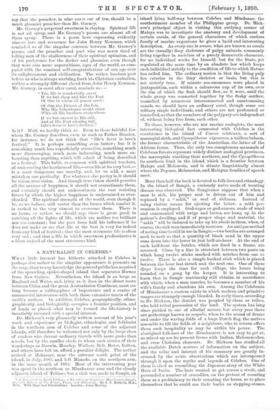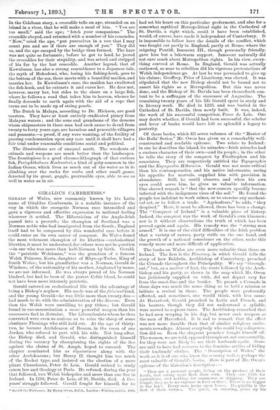A NATURALIST IN CELEBES.*
WHAT little interest has hitherto attached to Celebes is perhaps due rather to the singular appearance it presents on -the map, than to any knowledge the general public has acquired of the sprawling, spider-shaped island that separates Borneo from New Guinea. Nevertheless, the island is as large as England and Wales, and, lying as it does in the direct route between China and the great Australasian Continent, must ere long become a calling-place of importance and a centre of commercial intercourse with both those extensive tracts of the earth's surface. In addition, Celebes, geographically, ethno- graphically, and biologically, occupies a frontier position, and -of lands so placed, what may be termed the life-history is invariably invested with a special interest.
Dr. Hickson's very pleasantly written account of his year's work and experience as biologist, ethnologist, and folklorist in the northern arm of Celebes and some of the adjacent islands, will therefore be welcomed not only by the large class of readers who devour ordinary travels with more gusto than .novels, but by the smaller circle to whom such stories of their wanderings as Darwin, Moseley, Wallace, Belt, Bates, Galton, and others have left us, afford a peculiar delight. The author -arrived at Makassar, near the extreme south point of the island, in July, 188:5, and left Manado, on the northern arm, in the same month of 1883. Most of the intervening year was spent in the northern or Minahassar arm and the closely adjacent island of Talisse ; but a visit was made to S. ang,ir, an A Naturalist in North Celebes : a Narrative of Travels in blinahassar, Sangir, Jr., with Notic-s of the Fauna, Flora, and Ethnology. By S. T. Hickson, M.A., D.:ie. with Maps aud Illustrations. London: John knn:ay.
island lying half-way between Celebes and Mindanao, the southernmost member of the Philippine group. Dr. Hick- son's principal object in visiting this outlying corner of Malaya was to investigate the anatomy and development of certain corals, of the general characters of which curious family of marine organisms he gives a lucid and interesting description. As every one is aware, what are known as corals are the (usually) limy skeletons of pulpy animals, commonly living together in societies of a purely democratic character, for no individual works for himself, but for the State, yet regulated at the same time by an absolute law which keeps each individual strictly to the condition of life to which Nature has called him. The ordinary notion is that the living pulp lies exterior to the limy skeleton or basis, but this is not strictly true. If minute sea-anemones were placed in juxtaposition, each within a calcareous cup of its own, over the rim of which the flesh should flow, as it were, until the whole group was connected together by the fleshy outflow, tunnelled by numerous interconnected and anastomosing canals, we should have an ordinary coral, though some are solitary single individuals, and others are not perforated or tunnelled, so that the members of the polypary are independent of, without being free from, each other.
To those, however, who are not marine zoologists, the most interesting biological fact connected with Celebes is the coexistence in the island of Cuscus celebensis, a sort of marsupial sloth, and Cynopithecus nigrescens, a tailless baboon, , the former characteristic of the Australian, the latter of the African fauna. Thus, the only two conspicuous mammals of Celebean forests represent widely distinct zoological provinces, the marsupials reaching their northern, and the Cynopithecus its southern limit in the island, which is a frontier between Malaya and Melanesia, and is situate linguistically almost where the Papuan, Melanesian, and Malayan families of speech meet.
More than half the book is devoted to folk-lore and ethnology. In the island of Sangir, a curiously naïve mode of treating disease was observed. The Sangirenes suppose that when a man is sick, his proper soul is driven out of him and replaced by a " sakit," or soul of sickness. Instead of using violent means for ejecting the latter, a mild per- suasion is employed. God-cages or god-canoes, made of wood and ornamented with twigs and leaves, are hung up in the patient's dwelling, and if of proper shape and material, the " sakit " will be induced to take up his abode in them, when, of course, the sick man immediately recovers. An antique method of noting time is still in use in Sangir,—two bottles are arranged neck to neck so that a quantity of black sand in the upper runs down into the lower in just half-an-hour. At the end of each half-hour the bottles, which are fixed in a frame, are reversed. Close by a line is stretched between two posts on which hang twelve sticks marked with notches from one to twelve. There is also a simple hooked stick which is placed between the hour last struck and the next one. One of these djaga keeps the time for each village, the hours being sounded on a gong by the keeper. It is interesting to learn that in Sangir matriarchy still obtains, in accordance with which, when a man marries, he becomes a member of his wife's family and abandons his own. Among the Celebeans of Minahassar a custom exists in which modern and primitive usages are strangely enough blended. In early times, according to Dr. Hickson, the district was peopled by clans or tribes, who held tribal possession of the land. The system has long since yielded to one of allodial nature, but every year there are gatherings known as mapalu, when to the sound of drums and under the waving folds of a huge Dutch flag, the natives assemble to till the fields of a neighbour, who in return offers them such hospitality as may be within his power. The aboriginal folk-lore of the Minahassers is not easy to get at, so mixed up are its present forms with Indian, Mahommedan, and even Christian elements. Dr. Hickson has studied all the available Dutch sources of information on the subject, and the value and interest of his summary are greatly in- creased by the acute observations which are interspersed through it upon the myths and legends of Celebes. One of them is cited as resembling the Japanese story of the White Hare of Inaba. The hare wanted to get across a strait, and persuaded a number of crocodiles, on the pretext of counting them as a preliminary to their counting the hares, so to place themselves that he could use their backs as stepping-stones.
In the Celebean story, a crocodile tells an ape, stranded on an island in a river, that he will make a meal of him. "You are too small," said the ape; "fetch your companions." The crocodile obeyed, and returned with a number of his comrades. "Now," cried the ape, "put yourselves in a row that I may count you and see if there are enough of you." They did so, and the ape escaped by the bridge thus formed. The hare was not quite so fortunate; before he got to land, he jeered the crocodiles for their stupidity, and was seized and stripped of his fur by the last crocodile. Another legend, that of Kawuluaan, has also a strong resemblance to a Japanese tale, the myth of Hohodemi, who, losing his fishing-hook, goes to the bottom of the sea, there meets with a beautiful maiden, and marries her. In Kawulusan's case, the maiden has swallowed the fish-hook, and he extracts it and cures her. He does not, however, marry her, but rides to the shore on a large fish, where he follows a road that takes him to heaven, whence he flally descends to earth again with the aid of a rope that turns out to be made up of string pearls.
The Dutch in Malaya, according to Dr. Hickson, are good masters. They have at least entirely eradicated piracy from Malayan waters ; and the sons and grandsons of the demons whom shipmasters in these seas had such cause to dread from twenty to forty years ago, are harmless and peaceable villagers and peasants,—a proof, if any were wanting, of the futility of passing condemnation upon any race until it shall have had a fair trial under reasonable conditions social and political.
The illustrations are of unequal merit. The woodcuts of animals and weapons are much better than the landscapes. The frontispiece is a good chromo-lithograph of that curious fish, Periophthaknms Hoelreuteri, a kind of goby common in the Indian Ocean, which lives as much out of the water as in it, climbing over the rocks for crabs and other small game, detected by its great, goggle, protrusible eyes, able to see as well in water as in air.



































 Previous page
Previous page